Gods & Goddesses
India is one of the most religiously diverse nations in the world, with religion playing a central role in the lives of most Indians. 80% of the people in India are Hindus, considered one of the oldest religious and philosophical systems in the world. Islam is practiced by 13.4% of all Indians, Christianity by 2.4%, and Sikhism by 1.86%. Buddhism and Jainism both arose on the Indian subcontinent and have a world-wide presence; in addition, Zoroastrianism and Judaism have a long history in India, but their present-day numbers are small.
Hinduism is supposed to be 'apauruseya', i.e., of impersonal origin & so also are the Gods of Hinduism. They are eternal & though the deities appear to be different & independent, they are really facets of the same Brahman, the Supreme God.
As Sri Ramakrishna says, there can be as many spiritual paths as there are spiritual aspirants & similarly there can really be as many Gods as there are devotees to suit the moods, feelings, emotions & social background of the devotees.
The Hindu scriptures were eloquent while describing the qualities of God. He is all-knowing & all powerful. He is the very personification of justice, love & beauty. He is ever ready to shower His grace, mercy & blessings on His creation.
From the Rig Veda, we come to know of the vedic gods eight Vasus, eleven Rudras, twelve Adityas, Indra & Prajapathi, being the Gods of earth, the heavens & the space.
The main Hindu Gods as we accept today can be broadly classified as Saiva Gods (Siva, His consort, His sons, His other forms), Vaishnava Gods (Vishnu, His consort, His various avatharams)& Sakthi or Saktha (Forms of Goddess Sakthi).
Bhrama - The Lord of creation, One of the Trinity
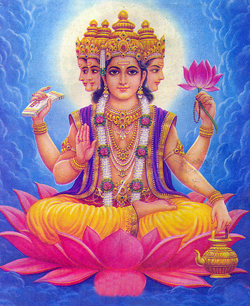
Brahma is the Lord of creation & is assisted in this process by his consort Saraswathi, who is the possessor of ultimate knowledge. Together, they thus introduce the soul into the cycle of life; Brahma was born from the navel of Lord Vishnu at the end of one cycle to begin a fresh creation. He has four heads (originally five), representing the four vedas which are said to have sprung from his heads. His four heads are also said to represent the four yugas. He is bearded & his eyes are closed in meditation. He sits on a lotus & his vahana is the swan. In his four arms he holds the vedas, the kamandalam (water pot), suruva (sacrificial spoon) & a mala. He is a serene soul and is the provider of all sources of knowledge & wisdom.
There are no temples for Brahma (except the ones in Rajasthan & Orissa) as for Siva & Vishnu, for there has been no separate cult for Brahma as the Saiva or Vaishnava cult. According to mythology, he is supposed to have been cursed by Shiva (for his having uttered a lie & for his ego) that he would go without worship. Yet in all Siva & Vishnu temples, there is an image of Lord Brahma on the northern wall & he is one of the important Parivara devata (attendant deity).
Vishnu - Lord of Protection, One of the Trinity

Vishnu is the Lord of protection, sustenance & maintenance. His consort Lakshmi is the possessor of wealth, which is a necessity for maintenance. Goddess Lakshmi represents not only material wealth, but the wealth of grains, courage, valour, offspring, success, luxurious life, eternal bliss. Vishnu and Lakshmi thus help the souls introduced into the life cycle by Brahma to survive in the cycle of life; Lord Vishnu is also called Nilameghashyamalan - possessing a complexion the colour of the dark clouds. As proof that opposites attract, Vishnu's outer appearance is dark while he is associated with the santha gunam, bringing light & peace to the world. He rests on the ocean on his bed of Adisesha (serpent with 1,000 heads). Any time Lord Vishnu sees great trouble, He takes an avataram to rescue the people from evils. He is all merciful, ever rushing to serve his devotees. In the form of Mahavishnu he has four arms wielding the chakra, conch, lotus & the gadha or mace in his four arms. Some of the main avatarams of Vishnu are enumerated as the Dasavataram (10 Incarnations).
Shiva - Lord of Destruction, One of the Trinity

Siva, the last of the Trinities is the God of destruction & he is assisted in this by his consort Parvathi, the Goddess of disintegration. Parvathi represents sakthi, to disintegrate perishable matter, in the absence of which true and complete destruction by Siva becomes impossible. This could possibly be the meaning of the idea that Siva becomes nothing in the absence of Sakthi.
Siva is generally worshipped in the form of the phallus (linga) fixed on a pedestal. Energy can neither be created nor destroyed & the Linga symbolises this scientific fact. The Linga denotes the primeval energy of the Creator. At the end of Creation all Gods find their resting place in the Linga - Brahma being absorbed into the right, Vishnu being absorbed into the left & Gayathri Devi being absorbed into the heart of the Linga. Linga, the emblem of Siva is the main form worshipped in Siva temples. Siva in his human form is worshipped as the Utsava murthi, taken out on processions.
Siva Lingams worshipped in temples are mostly made of stone & consists of three parts. The lowest portion in the shape of a square symbolises Brahma (the God of Creation). The middle part in the shape of an octagon symbolises Vishnu (the God of Maintenance). These two portions are embedded inside a pedestal. The cylindrical portion projecting from the pedestal symbolises Shiva the God of Destruction).
Siva resides high up on snowy mountain ranges. Image of Siva in his physical form presents him as a soothing meditative figure. His ornaments are not gold & precious stones. He wears a necklace made of skulls signifying his role as destructor. He has snakes coiling all over his body & his hair is matted and long extending over the whole sky & space. The crescent moon adorns his crown, signifying his control on the time cycle.(Amavasay & Pournami). He smears his body with ashes & wears a tiger skin and elephant skin. He has a third eye on his forehead which is the source of knowledge & wisdom. The holy Ganges is imprisoned in his flowing locks. In his two arms he holds the Trisulam (the three prongs representing the three gunas of sattva, tamas & rajas) in one & Damaru in the other. His vahana is the Nandi, who is also his chief disciple to whom Siva passed on all his immense knowledge in arts.
The above description should convey him as an angry & destructive image, yet being the source of all knowledge he is often in a meditative pose with half closed eyes looking out into the universe as well as in to his inner self, signifying that his act of destruction is in itself an act of creation for in the absence of destruction there can be no creation.
Lord Ganesha - Remover of Obstacles

Lord Ganesha is the most widely worshipped Hindu God. He is worshipped at the start of any action or venture, for he is considered to be the Lord who removes obstacles (vignam) and hence is also called Vigneshwara. He has an elephant head, four arms. In his upper hands he holds the paasam (noose) and ankusam. The lower two hands are held in the abhaya and varada mudras. He is also seen holding his broken tusk in his right lower hand and a modhakam in his left lower hand. He has a huge belly and is fond of various sweets and fruits. He wears a snake as an ornament round his belly. He is depicted in seated, standing and dancing postures. He is considered a bachelor, but according to another school of thought, he has two Sakthis - Siddhi & Buddhi. Siddhi represents success and prosperity. Buddhi represents wisdom. His vahana is a tiny mouse (mooshikam or minjur).
Lord Muruga - Destroyer of Sura Padman
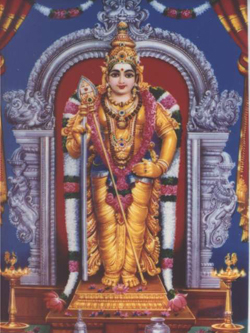
Muruga is the second son of Siva and Parvati, brother of Lord Ganesha. Muruga is worshipped widely in Southern India, especially in Tamilnadu. In fact, he is called the Tamil Kadavul (The Lord of the Tamil people). He was once upset that Lord Siva gave the sacred fruit to Ganesha and tricked him out of winning it. He is said to have left the Himalayas, the abode of Lord Siva & Parvati and settled down on a hill top in Tamilnadu in the South. Most of the Murugar temples are located on top of small hills and he is also known as the Kundra Kadavul (Lord who is seated on a hill, kundru - hill).
He was born for the sole purpose of destroying Sura Padman, an asura who was giving immense trouble to the Devas & rishis Lord Muruga is considered very handsome, brave, just. Even though he was seen as a playful youngster, he was also extremely knowledgeable – enough to test Lord Brahma himself. When reprimanded by Lord Siva, he justified his action by telling Siva the meaning of the OM (pranava mantram). He is therefore known as Swaminathan, one who preached even to Siva. His other namas (names) are Subrahmanya, Shanmukha, Kaartikeya, Skanda, Kumara, Devasenapati, Saravanabhava, Guha, Swaminathan, etc. Lord Muruga has two consorts - Valli and Devasena. Valli is a tribal girl and Devasena is the daughter of Indra, the king of the Devas. His mount is the peacock.
Lord Hanuman - The Monkey God
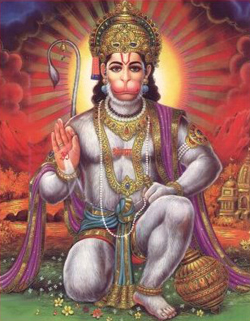
Hanuman, the monkey God is considered Chiranjeevi (will live eternally). He is stong, full of valour, with various skills and powers. At the same time , he is wise, a great gnani, a yogi, a brahmachari. He had the one thought only - that of serving his Lord Rama with utmost humility and devotion. He is known as Siriya Thiruvadi. He is considered to be an amsam of Lord Siva.
He is worshipped in the temples as Bhaktha Hanuman & Veera Hanuman. He is seen seated humbly in front of Rama vigrahmas in the Rama sannadhis. There are also separate temples for Hanuman. As Bhaktha Hanuman he is seen holding both hands together in prayer. He is seen as Veera Hanuman, holding the mace in one hand & the sanjeevi Parvatham in the other. Devotees are blessed with courage, valour, wisdom, gnanam. He is very happy when he hears the Rama namam. Hence repeating the Raama namam is the best way to get his blessings.
Saraswathi - Goddess of Wisdom and Learning
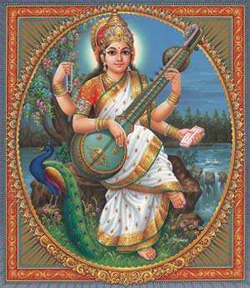
Goddess Saraswathi is the consort of Lord Brahma (Lord of Creation) and is the Goddess of wisdom and learning. She is considered as the personification of all knowledge - arts, sciences, crafts and all skills. She is seen as a beautiful and elegant presence, pure white in colour, clad in a white sari, seated on a white lotus, representing purity and brilliance. She is depicted with four hands. In one hand she holds a book and in the other a rosary. With her other two hands, she is seen playing the veena. Her vahana is the swan and sometimes a peacock is shown accompanying her. The swan is known for its exceptional characteristic of being capable of seperating out water from milk, indicating that we should possess discrimination to segregate the bad from the good. Like Brahma, she is not worshipped much in temples. However, every year the Saraswathi Pooja (Navarathiri) is celebrated by all - schools, students, workers, craftsmen, businessmen offering their prayers for a successful and fruitful coming year.
Lakshmi - Goddess of Wealth & Prosperity
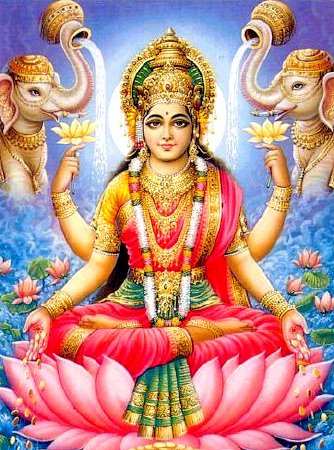
Goddess Lakshmi is the consort of Lord Vishnu (Lord of Protection Maintenance & Preservation). To go hand in hand with Lord Vishnu's act of maintenance and preservation, Goddesses Lakshmi is the possessor of every form of wealth. "Sri" is consdiered to be a pre-vedic deity associated with fertility, water and this deity was later merged with the vedic deity of beauty, Lakshmi. The word Lakshmi could have its origin from the sanskrit terms lakShyam meaning goal lakShaNaM meaning aspect; characteristics lakSha meaning Lakh, 100,000 in number, also sight lakShaM meaning target Thus Goddess Lakshmi is the source of wealth, fortune, prosperity, love and beauty. In the avatarams of Lord Vishnu, Lakshmi took various forms to accompany him - Sita with Rama, Rukmini with Krishna. She is the possessor of great beauty and is depicted in standing as well as in the seated postures, always on a lotus. In her hands she holds two lotuses and wears a garland of lotus. She is often depicted clad in a red saree. She is accomapnied by two (sometimes four) elephants on either side either garlanding her or spraying water from pitchers. She has four arms. The two upper arms are holding lotuses, while the lower arms are normally in abhaya and varada mudras. She has on her lap, a pot overflowing with gold and other riches. She is also depicted sometimes holding the amirtha kalasam (pot of ambrosia) and bilva fruit. Ashta Lakshmi are her eight forms which are the commonly worshipped aspects. In each form, she bestows one form of wealth to her devotees.
Kali/Parvathi - Goddess of Time

Parvathi is Lord Siva's consort & like Lord Siva, she is portrayed in her roudra & serene aspects.In her serene aspect, she is depicted as Uma or Parvathi & is usually seen along with Siva & also their children Lord Ganesha & Lord Muruga. She is seen with only two hands, holding a blue lotus in her right hand.
In her terrifying aspects, the most commonly worshipped forms are Durga & Kali. These are forms taken by the Goddess in an effort to destroy some form of evil & hence even these forms need not invoke fear, for she is the mother who has risen in anger only to destoy evil forces and provide eternal happiness and peace to her children. As Durga she is seen with four - twenty hands. She has 3 eyes, the 3rd eye in her forehead. She is adorned in bright red sari. In her hands she holds the discuss, bow, trident, bow & arrow, sword, gadha, etc., Her vahana is the lion and she is sometimes seen as standing on a lotus or on a buffalo's head.
As Kali (the Goddess of Time) she presents the most terrifying aspect, usually seen in a burial or war field. She is standing on a dead body with her hair let loose and dishivelled. She wears a garland of skulls.